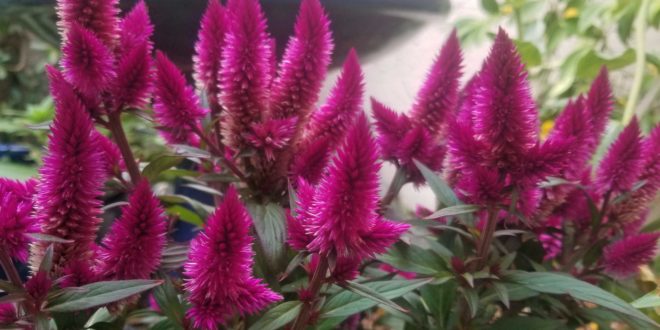Celosias, also known as cockscomb, feathered amaranth, woolflower and red fox, are warm-weather flowering plants that thrive in hot, humid Mediterranean areas. They are commonly grown as annuals but can survive winters in U.S. Department of Agriculture plant hardiness zones 10 and 11. Plant height is generally between 6 inches and 3 feet. Celosias in the “Childsii” and “Cristata” groups have rounded flowers, those in the “Plumosa” group have arrowhead-shaped flowers and those in the “Spicata” group have bottle-brush type flowers. They are all easy to care for as long as their soil and sunlight requirements are met.
Sunlight and Drainage
Celosia plants require a minimum of eight hours of direct sunlight and soil that drains quickly. Poorly draining planting sites can cause them to develop root rot. To test how quickly the soil drains, remove the top and bottom from a large coffee can, dig a 4-inch-deep hole in the soil, the same circumference as the can, and insert the can into the hole. Fill the can with water and check the water level after one hour. If the water level drops between 2 and 5 inches, the drainage is good. When the water level drops less than 2 inches, the drainage is poor. Perlite can be added along with soil amendments to improve the soil’s drainage or you can plant celiosa in containers or raised beds.
Organic Matter and pH
Celosias will grow in nutrient-poor, sandy soil but thrive and bloom more profusely in soil that contains high levels of organic matter. Soil pH levels between 6 and 6.5 are best. In fall, before planting Celosia, prepare the planting site by removing weeds and mixing organic matter into the soil. Even sandy loam soil, considered ideal for most annuals, should have organic matter mixed in each year to maintain consistency and fertility levels. Leaf mold, peat, well-aged cow manure and compost are suitable soil amendments. Depending on how much organic matter is already in the soil, spread a 3- to 6-inch layer of soil amendment over the planting site and work it into the soil thoroughly to a depth of 10 to 12 inches. Sulfur may be added to lower the pH and lime can be used to raise the pH.
Planting and Watering
Celosia can be planted in the garden after April. They will be damaged if the ground temperature drops lower than that. Immediately after planting them, water them generously to settle the soil around the roots. A 3-inch layer of organic mulch can be spread around them to control weeds and help maintain moisture levels. Water them as often as necessary to keep the soil consistently moist.
Fertilizing, Pinching and Deadheading
Fertilizer may not be necessary. If the plants seem to be growing slowly, apply water-soluble fertilizer with a 3-1-2 ratio every two weeks or use a slow-release granular fertilizer. Tie the flowers on taller cultivars to stakes to keep them from falling over or pinch the stems back as they grow to encourage a more bushy plant. Using clippers sanitized with rubbing alcohol, remove the flowers as they fade to promote more flowers.
Pests and Disease
Fortunately, celosia is not susceptible to serious damage from insects or diseases. If your soil doesn’t drain well, your plants may develop root rot, which appears in wilted or discolored leaves, so make sure you amend the soil with compost or sand before planting, or dig in some organic matter around existing plants. Fungal diseases, such as molds or powdery mildew, turns leaves brown and may kill the plant. Use a commercial fungicide and remove damaged leaves to minimize the damage.








